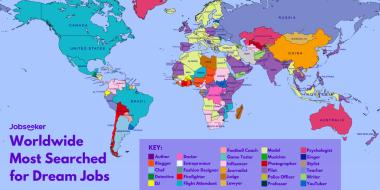How to list publications on a resume (with examples)
Wondering how to list publications on resumes? Discover the key to making sure your hard work and knowledge shine through on your next job application.

Every job seeker knows that demonstrating accomplishments and deep industry knowledge is key to landing that dream role.
Whether you’re in academia, science, healthcare, technology, finance, or journalism, highlighting your byline or authorship on a peer-reviewed or highly regarded publication can help hiring managers see your expertise in black and white, putting you miles ahead of the competition.
In this article, you’ll learn:
- How to list publications on resumes
- What kinds of publications should go on a resume
- When to list publications on your resume (and when they’re better left off)
- Where to discuss your publications
- Tips for formatting your references
We’ll provide concrete examples of how to cite publications in resumes for various industries. By the time you’ve finished reading, you’ll know how to make your qualifications shine and show hiring managers why you’re perfect for the role.
What are publications?
Publications are formally published works that you’ve authored or contributed to in some way. They typically include professional works, such as:
- Research papers
- Trade magazine articles
- Journal articles
- Books
- Presentations to industry peers
If you’re wondering “What are publications that are appropriate for resumes,” you should know that they typically don’t include personal writing or self-published pieces like blogs, newsletters, social media posts, or hobby articles.
Peer-reviewed publications are especially impressive, as they indicate that your work has been evaluated for quality and validity by other industry experts. The purpose of including high-quality publications in your resume is to highlight your expertise and your ability to articulate complex topics for various audiences.
What kind of publications should you list on a resume?
The types of publications that should be included with your job application differ depending on the industry and role you are applying for. For roles in academia, science, or research, include works that are authoritative, peer-reviewed, and published or about to be published, such as:
- Scholarly articles
- Conference papers
- Research papers or studies (including your published thesis or dissertation)
- Academic books
If your work is currently unpublished, there are some best practices you can draw from regarding how to put pending publications in resumes. Usually, you’ll include them in a separate category labeled as such.
Expert Tip
For academia, research, and science roles, do not use a resume template that includes online or print articles that were published in non-scientific or non-academic publications, such as blog posts or magazine articles.
If you are submitting a resume for other industries or roles, you can include a broader range of publication types, as long as they are appropriate and relevant to the job you are applying for. For example, you can include:
- Books or portions of books that you’ve authored
- Articles published in trade association magazines or on relevant websites
- Works that have been published in industry journals
- Blogs, blog posts, magazine articles, or websites (especially if you are applying to a writing, content marketing, or similar role)
- Journalistic publications like newspapers or news website articles
- Other published examples of your work that are pertinent to your job application
When should you list publications on your resume?
While you may now understand how to list publications on a resume, it can be challenging to know when listing publications is appropriate and when they’re better left for another time. Here are two critical instances in which listing publications can benefit your job search.
When they’re relevant
It’s a good idea to list publications on resumes whenever they are relevant to the job that you are applying for. Adding your pertinent publications shows potential employers that you are experienced in the industry and that you have strong written communication skills. Publications can also demonstrate analytical skills, research abilities, and subject matter expertise.
When applying to fields where they’re the norm
If you are applying to a job in an academic, scientific, or medical field, you may be asked to submit a curriculum vitae (CV) instead of a resume.
In other parts of the world, "resume" and "CV" are used interchangeably. But in the United States and Canada, a resume is a short document that is used for applying for jobs in any industry, while CVs are longer, more comprehensive documents that are specifically used in the three fields mentioned above.
If you are asked to submit a CV for a job application in the United States or Canada, you should absolutely create a section for your publications and include all authoritative works that you have authored, co-authored, or contributed to.
Understanding appropriate resume length
It’s acceptable for your resume to be several pages in length since it is essentially a history of your entire education and professional experience. You will likely be asked to submit a resume, and you should definitely include your publications if you are applying for roles such as:
- Researcher or research assistant
- Professor or assistant professor
- Dean or other higher education administrative/leadership positions
- Scientist
- Laboratory director
- Medical doctor
Though there are instances where your document can be more than one page, it’s important to know how to include your publications on resumes without making them too long. Your resume should be no longer than one page if you have less than 10 years of experience, and no longer than two pages if you have more experience than that.
How to list publications on your resume
Here are a few tips to help you better understand how to cite publications in resumes:
Step 1: Decide where to list publications
If you’re submitting a resume for a job in research or academia, you can create a research and publications section within the body of the document, or you can add a separate page at the end for your publications.
Especially if you have a large body of work, creating a separate page can help keep your resume organized and readable. If you are submitting a resume for another role or industry, you can simply create a publications section and list your works there.
Step 2: Choose a citation style
Choose the appropriate citation style for your field. Most science and engineering fields use APA style, while humanities fields (philosophy, history, language, etc.) typically use MLA style. Regardless of which format you choose, use it consistently for every publication on your resume.
As a reference, here are the different style guidelines to follow when listing your publications on a resume:
APA style - journal publication
Author last name, First initial. Middle initial. (Year of publication). Article title. Journal title, Volume (Issue), Page range.
APA style - book
Author last name, First initial. Middle initial. (Year of publication). Book title: Subtitle. Location: Publisher.
MLA style - journal publication
Author last name, First name. “Article Title.” Journal Title, Volume, Issue, Date, Pages.
MLA style - book
Author last name, First name. Book Title: Subtitle. Publisher, Year.
Step 3: Use reverse-chronological order to list your publications
List your publications in reverse-chronological order, with the most recent at the top and working backwards in time from there. You can include pending publications - simply italicize that entry and omit the name of the journal or publication that you have submitted it to. You may choose to leave off publications that are old, irrelevant to your target position or field, or no longer useful.
Here are a few resume examples that demonstrate how you might incorporate a properly formatted publication list:
- Andrews, M.C. (2022). Anxious Attachment: How Children Learn to Form Healthy Relationships. Nashville, Tennessee: Merriweather University Press.
- Andrews, M.C., Ching, L.K. (2017). Analyzing the post-partum bonding process. Child Development Perspectives, 12 (122), 94–97.
- Andrews, M.C. (2016). What drives separation anxiety in toddlers? The Journal of Pediatrics, 4 (19), 12–16.
Using reverse-chronological order when learning how to put publications on resumes is important, as it makes it easy for hiring managers to understand your most recent work and demonstrates ongoing engagement in the field.
Step 4: Verify all the details of your publications
Ensuring accuracy when listing publications in resumes demonstrates professionalism and integrity while building credibility. It also allows hiring professionals to access and review your work.
One missed detail, such as an incorrect title, publication date, or issue number, can mean the difference between easily locating your book or journal article and having to chase you down for more details — or wondering whether your work exists at all.
Dos and don’ts of listing publications in your resume
The following guidelines for how to put publications on resumes will help you avoid pitfalls and ensure that your work highlights your expertise:
Do:
- Indicate which works are still unpublished or near publication
- Use clear section titles to delineate your publication list
- Stick to reverse-chronological order to align with hiring manager expectations
- Sort your publications into categories and label them
Don't:
- Use inconsistent citation styles
- List publications that are irrelevant to the role
- List publications with outdated information or research
- Forget to check your citations for accuracy
Keeping these tips in mind, along with the advice you’ve gathered from resume articles on how to put research on resumes, can help you make sure your work comes across accurately and professionally.
Examples of publication sections on resumes
When looking for information on how to put publications on resumes, examples can be helpful. Here’s what it might look like for those applying for roles in various industries:
Humanities professor
- Wentworth, Allison. “Teaching first graders how to read: an analysis of methods.” American Journal of Speech and Language, 12, 92, July 7th, 2025, 62–68.
- Wentworth, Allison, and Conway, George. “Working together: How language shapes collaborative practices and relationship building in professional settings.” Journal of American Studies, 72, 119, January 12th, 2022, 91–93.
- Wentworth, Allison. What It Means to Be a Friend: How to Change Your Relationships By Shifting Your Speech. Horton Press, 2019.
Research scientist
- Harper, B.A., Jackson, K.B. (2015). Analyzing DNA patterns among primates. American Journal of Primatology, 7 (125), 22–27.
- Harper, B.A. (2013). The effects of natural background noise on the behavioral patterns of Japanese macaques. The International Journal of Animal Science, 6 (44), 181–190.
- Harper, B.A., Andrews, M.C.(2012). The effects of early life rearing experiences on baboon development. Primate Research Perspectives, 66 (122), 483–494.
Journalist
- "How Phoenix Plans to Address Urban Traffic Congestion," Publication: The Arizona Daily Gazette, October 2, 2025
- "The Effects of Politics on Workplace Collaboration," TIME Magazine, July 25, 2023
- "Tactics for a New Tomorrow: How the Education System Can Turn Readers Into Leaders," Education Inc., February 19, 2023
Jobseeker’s resume builder can take the confusion out of how to put research on resumes. With resume and cover letter templates for a variety of industries, you’ll spend less time crafting your application and more time building skills in the field you love.
Key takeaways
Adding publications to resumes or cover letters can not only demonstrate your accomplishments and knowledge of your field but also showcase your ability to analyze broad concepts and write clearly about complex topics. When including your publications, keep the following points in mind:
- Understand the guidelines and best practices for various industries
- Ensure that any publications you list are current and relevant
- Use a consistent citation style that’s appropriate for your role
The examples included in Jobseeker’s resume builder can help candidates looking to put publications on resumes in any industry craft polished and professional documents that are sure to get them noticed.
Our useful tool features resume and cover letter examples and prompts to help you present your publications in the best possible light so you can finally land a professional role that truly suits you. To build on that, explore our resources for more related topics, examples, and templates that can help you refine every part of your application.
FAQs about listing publications on a resume
Adding publications to resumes can be ATS-friendly if your publication titles include key terms from the job description. However, you don’t need to change job titles for this purpose, as you can incorporate those terms elsewhere in your resume and cover letter.
You should include all relevant and up-to-date publications when determining how to list publications on resumes.
Yes. When learning how to put pending publications in resumes, it’s recommended that you group them into a separate category and label them accordingly.
Yes. However, you should avoid anything that isn’t considered professional writing, such as blogs or newsletters.
Impress potential employers with your resume
Follow step-by-step professional guidance to create a polished resume in minutes.



